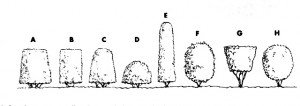I can’t help it!
No matter where I go, I look at the landscaping. I suppose for the sake of others I should be looking at the road or where I’m walking. Since nothing seems to change between my house, work and the places I shop at, all of you are safe. I just got back from vacation and it’s probably a good thing I didn’t do much driving. The landscaping on Cape Cod is stunning. The hydrangea were in full bloom! (I am still waiting to see a decent one here.) Huge Japanese maples that made me jealous and amazing mixed flower beds with a real wow factor were everywhere. But, once I got past the initial visual impact, I started to see the defects. Guess what? They can’t grow grass to save their seashells. Oh, there are isolated lush green lawns (heavily fertilized, irrigated and seeded yearly) but the average home lawn is a pitiful mix of weeds, grass, bare ground or mulch covering huge portions of what should be lawn…a big indicator that the owner has given up on grass.
What was missing?
What I didn’t see were mulch volcanoes around trees. The mulch they use is nicely spread and tapered…unfortunately, they have decided that the dyed red mulch is a thing of beauty (yes, I was rolling my eyes, gritting my teeth and trying to not gag). How this volcanic, crime against nature ever started in Houston, is beyond comprehension. I would gladly beat the 1st one that did it, with their own shoes. Why can’t the trees be left alone? What is wrong with grass growing up to the tree?
What I didn’t see were shrubs cut the wrong way. Yes, there is a wrong way! Shrubs should be wider at the bottom than at the top or be evenly pruned into circles or ovals. Those ice cream cone shapes that are all too common here make me want to scream. The foliage is just on the top and all you see from a distance are bare branches holding up, some bizarre, giant, other world, mushroom- looking things. Topiaries are not what I am talking about. Below are possible correct shapes with comments.
- A: is a properly pruned hedge shape. The wide bottom allows the foliage to grow in the sun and the plant will stay full, all the way to the ground.
- B: this form is a properly if it will get the full sun for 6 or more hours on both sides, with no other shrubs close by. Sun on only one side will cause defoliation on the shady side. You see this often when shrubs are planted too close to a building.
- C, D, & E: are variations on A. Wider at the top than at the bottom.
- F: shows a natural form that is typically untrimmed.
- G: is undesirable. The sun can’t reach the bottom of the foliage and it will continuously defoliate and become just a shell of leaves on the outside. This shape also causes too much shade on the front row of plants.
- H: is suitable for all sunny areas.
What I didn’t see was monoculture, which are endless plantings of the same thing. Plantings were a nice mix of colors, textures and heights. Yes, there are hedge rows (properly trimmed) but it wasn’t the only thing in the yard either. More often, I saw tall, mixed shrubs used to delineate a space. When did Houstonians get so lazy and uncreative, that slapping in a bunch of ligustrum or red tips, became the norm?
What I didn’t see was trash on the road sides…yeah, I am not going to hold my breath on that one for Houston…the rest we will work on, one yard at a time.

